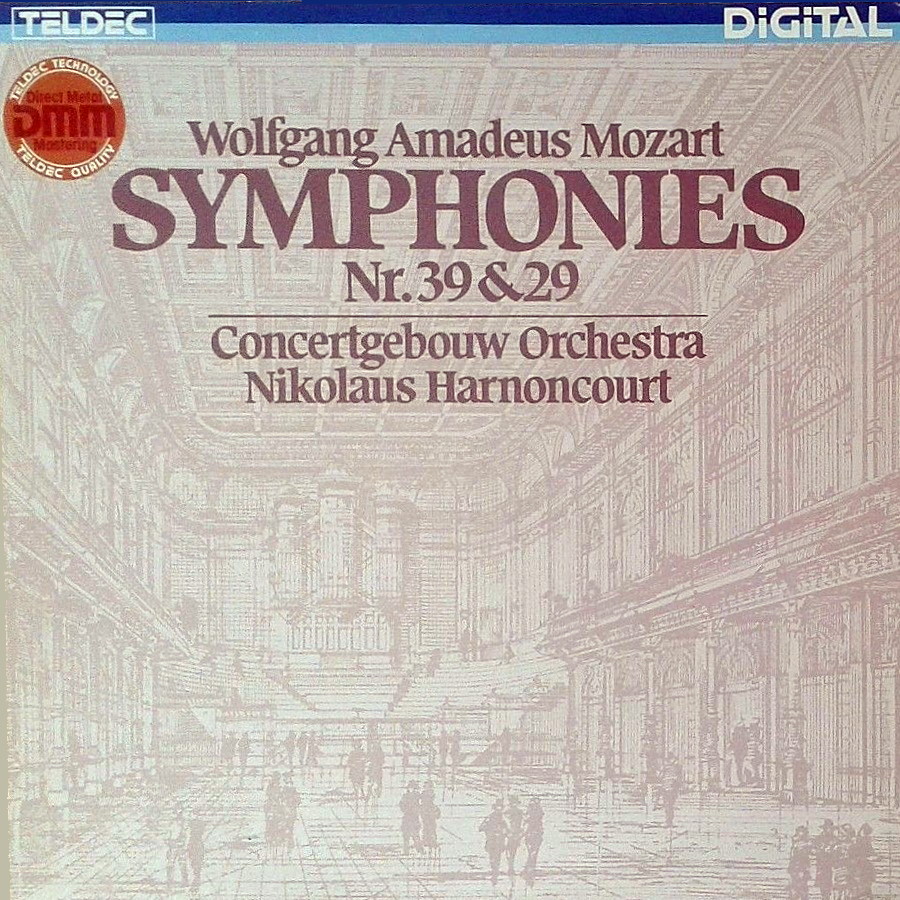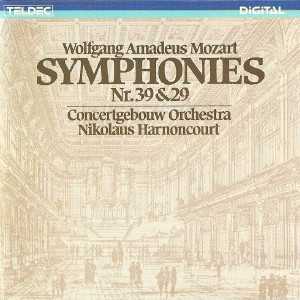 |
1 LP -
6.43107 AZ - (p) 1984
|
 |
| 1 CD -
8.43107 ZK - (p) 1984 |
|
| Wolfgang
Amadeus Mozart (1756-1791) |
|
|
|
|
|
|
|
| Symphonie Nr. 39 Es-dur, KV 543 |
|
29' 55" |
|
- Adagio - Allegro
|
11' 12" |
|
A1 |
- Andante
con moto
|
7' 30" |
|
A2 |
- Menuetto: Allegretto
|
3' 21" |
|
A3 |
- Finale: Allegro
|
7' 52" |
|
A4 |
Symphonie
Nr. 29 A-dur, KV 201 (186a)
|
|
29' 22" |
|
- Allegro moderato
|
10' 10" |
|
B1 |
| - Andante |
9' 28" |
|
B2 |
| - Menuetto |
3' 34" |
|
B3 |
- Allegro con spirito
|
6' 10" |
|
B4 |
|
|
|
|
| CONCERTGEBOUW ORCHESTRA,
AMSTERDAM |
|
| Nikolaus
Harnoncourt, Dirigent |
|
|
Luogo
e data di registrazione
|
Concertgebouw,
Amsterdam (Olanda) - giugno 1984
|
|
Registrazione
live / studio
|
| studio |
Producer
/ Engineer
|
-
|
Prima Edizione CD
|
| Teldec
- 8.43107 ZK - (1 cd) - 59' 40" - (p)
1984 - DDD |
Prima
Edizione LP
|
Teldec - 6.43107
AZ - (1 lp) - 59'
40"
- (p) 1984 - Digital
|
|
|
Notes
|
Mozart’s
Symphony m A major K. 201 - the second
in thia key that
he wrote in Salzburg - belongs to a
group of four-movement symphonies
composed between October 1773 and
November 1774: the “little”
G minor Symphony K. 183, dated
to 5th October
1773, K. 201 (6th April 1774), K. 202
in D major (5th
May 1774) and K. 200 in C major (12th
or 17th November 1774).
All four works bear
clear experimental traits; they
portray lofty and dramatic emotions
(frequently with the resources of
operatic language, among which
the agitated trernolo on the strings
figures largest), and they are marked
in formal terms by a predominance of
sonata movements. These culminate in a
coda, which is often expressly marked
as such - an element of formal design
and final climax of which Mozart had
previously made only seldom use, and
which again he subsequently had
recourse to only in exceptional works
- it is no coincidence that it appears
in extreme form in the first movemento
of the great G minor Symhony K. 550.
Mozart seems to have reached a
temporary threshold with these four
symphonies - for a period of almost
four years, he did not write any more
symphonies, concentrating instead on concerti
and serenades. And when he did return
to the symphonic genre, it was with an
occasional compositon that had no
connection with the Salzburg works of
1773/74: the “Paris” Symphony.
In terms of form, K.
201 is the strangest of
the four experimental Salzburg
symphonies - apart
from the minuet, every movement is a
sonata movement with a coda; it ist
the most chamber musical in accent.
This is most evident in the
development of the middle parts in all
the movements, in the delicately
proportioned thematic material of the
first movement and the tonal magic of
the slow movement. The minuet is the
most “symphonic” and the most remote
from the traditional dance that Mozart
wrote in these years. The finale is an
unusually dramatic movement for the
traditionally bucolic,
amicable key of A major: the
development is extremely concentrated,
the 6/8 time alone providing a faint
reminiscenee of the bucolic tradition.
K. 543. dated 26th June l788,
is the first of the three great
symphonies Mozart wrote in the summer
of 1788, apparently without external
motive and without any prospect of
having them performed or published.
However, there were in fact two
factors that might have stimulated
Mozart to make this last and greatest
symphonic exertion: the circulation of
Haydn’s six “Paris” Symphonies, and
the publication a year earlier of the
three major symphonies by Leopold
Kozeluch. It is scarcely a coincidence
that Haydn’s first three "Paris"
Symphonies are in the same keys as the
Mozart works (C, G minor and E flat),
that both the E flat major symphonies
open with a slow introduction, that
Mozart strikes up a pointedly
“Haydnesque” tone in the finale of his
work, and that there are affinities
between Kozeluch`s G minor symphony
and Mozart’s in the same key.
Notwithstanding, Mozart’s E flat major
symphony is a quite different work
from Haydn’s. The chief difference
lies in the fact that the dramatic
composer Mozart brings out
emphatically the character of the key
consolidated by
operatic tradition: the high pathos of
the ombra scenes and priestly
ceremonies that was to mark the “Magic
Flute” three years later. Dotted
rhythms and triad motifs, march tempo
and resplendent instrumentation - most
evident in the introduction, which
alludes clearly to the French overture
model, already an anachronism at that
time - accentuate this basic
posture, with which the broadly
conceived lyrical cantilenas contrast
all the more effectively. Not until
the whirling finale do pathos and
lyrical selfabsorption finally
dissolve into playful high spirits.
Ludwig
Finscher
Translation: Clive R. Williams
|
|
Nikolaus
Harnoncourt (1929-2016)
|

|

|
|